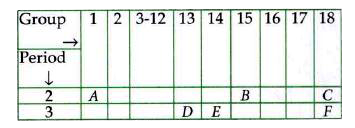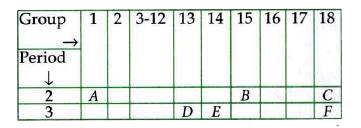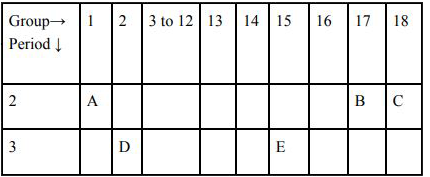The following table shows the position of six elements A, B, C, D, E and F in the Periodic Table.

Using the above table answer the following questions: (a) Which element will form only covalent compounds? (b) Which element is a metal with valency 2? (c) Which element is a non-metal with valency 3? (d) Write a common name for the family of elements C and F. (e) Out of D and E, which one has a bigger atomic radius and why?
(a) E (b) D (c) B (d) The noble gases. (e) D has bigger atomic radius. The atomic radius decreases in moving from left to right along a period. This is due to an increase in nuclear charge which tends to pull the electrons closer to the nucleus and reduces the size of the atom.
Topper's Solved these Questions
- PERIODIC CLASSIFICATION OF ELEMENTS BOOK - VK GLOBAL PUBLICATIONCHAPTER - PERIODIC CLASSIFICATION OF ELEMENTS EXERCISE - LONG ANSWER QUESTIONS
17 Videos
- PERIODIC CLASSIFICATION OF ELEMENTS BOOK - VK GLOBAL PUBLICATIONCHAPTER - PERIODIC CLASSIFICATION OF ELEMENTS EXERCISE - HIGHER ORDER THINKING SKILLS
10 Videos
- PERIODIC CLASSIFICATION OF ELEMENTS BOOK - VK GLOBAL PUBLICATIONCHAPTER - PERIODIC CLASSIFICATION OF ELEMENTS EXERCISE - SHORT ANSWER QUESTIONS-I
23 Videos
- MODEL QUESTIONS PAPER - 5BOOK - VK GLOBAL PUBLICATIONCHAPTER - MODEL QUESTIONS PAPER - 5EXERCISE - SECTION B
3 Videos
- PRACTICAL BASED QUESTIONSBOOK - VK GLOBAL PUBLICATIONCHAPTER - PRACTICAL BASED QUESTIONSEXERCISE - Experiment 15
4 Videos
Similar Questions
The following table shows the position of six elements A, B, C, D, E and F in the period table.

Using the above table answer the following questions :
(a) Which element will form only covalent compounds ?
(b) Which element is a metal with valency 2 ?
(c) Which element is a non-metal with valency of 3 ?
(d) Out of D and E, which one has more atomic radius and why?
(e) Write a common name for the family of elements C and F.
View SolutionIn the following table, the positions of six elements A, B, C, D, E and F are given as they are in the Modern Periodic Table:

On the basis of the above table, answer the following questions:
(i) Name the element which forms only covalent compounds. (ii) Name the element which is a metal with valency three. (iii) Name the element which is a non-metal with valency three. (iv) Out of B and C, whose atomic radius is bigger and why? (v) Write the common name for the family to which the elements D and F belong.
View SolutionStudy the following table in which positions of six elements A, B, C, D, E and F are shown as they are in the modern periodic table

On the basis of the above table, answer the following questions
Name the element which forms only covalent compounds
View SolutionStudy the following table in which positions of six elements A,B,C,D,E and F are shown as they are in the modern periodic table.

On the basis of the above table, answer the following question :
(i) Name the element which form only covalent compounds.
(ii) Name the element which is a metal with valency three.
(iii) Name the element which is a non-metal with valency three.
(iv) Out of D and E, which is bigger in size and why ?
(iv) Write the common name for the family to which the elements C and F belongs.
View SolutionStudy the following table in which positions of six elements A, B, C, D, E and F are shown as they are in the modern periodic table

On the basis of the above table, answer the following questions
Name the element which is a metal with valency three
View SolutionStudy the following table in which positions of six elements A, B, C, D, E and F are shown as they are in the modern periodic table

On the basis of the above table, answer the following questions
Name the element which is a non-metal iwth valency three
View SolutionThe position of certain elements in the Modem Periodic Table are shown below.

Using the above table answer the following questions giving reasons in each case:
(i) Which element will form only covalent compounds?
(ii) Which element is a non-metal with valency 2 ?
(iiii) Which element is a metal with valency 2 ?
(iv) Out of H, C and F which has largest atomic size.
(v) To which family does H, C and F belong.
View SolutionThe following table shows the positions of six elements A, B, C, D, E and F in the modern periodic table

(i) Which element will form only covalent compounds ?
(ii) Which element is a metal with valency two ?
(iii) Out of D and E, which one has a bigger atomic radius ? Give reason for your answers.
View SolutionThe following table shows the position of five elements A, B, C, D and E in the modern periodic table.

Answer the following giving reasons:
(i) Which element is a metal with valency two?
(ii) Which element is least reactive?
(iii) Out of D and E which element has a smaller atomic radius?
View SolutionStudy the following table in which positions of six elements A, B, C, D, E and F are shown as they are in the modern periodic table

On the basis of the above table, answer the following questions
Out of D and E, which is bigger in size and why?
View Solution
